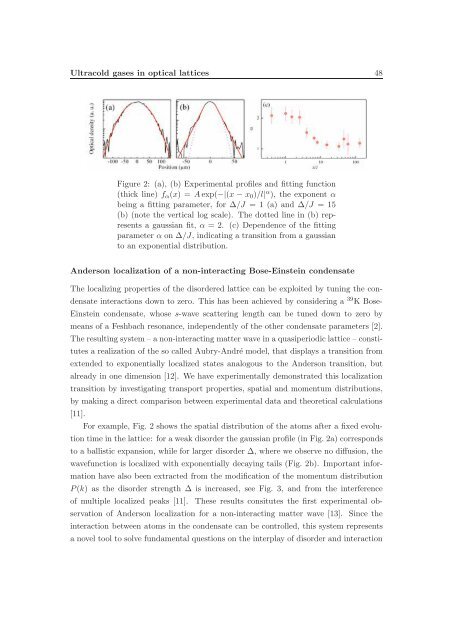Scientific Report - BEC
Scientific Report - BEC
Scientific Report - BEC
Create successful ePaper yourself
Turn your PDF publications into a flip-book with our unique Google optimized e-Paper software.
Ultracold gases in optical lattices 48Figure 2: (a), (b) Experimental profiles and fitting function(thick line) f α (x) =A exp(−|(x − x 0 )/l| α ), the exponent αbeing a fitting parameter, for Δ/J =1(a)andΔ/J =15(b) (note the vertical log scale). The dotted line in (b) representsa gaussian fit, α = 2. (c) Dependence of the fittingparameter α on Δ/J, indicating a transition from a gaussianto an exponential distribution.Anderson localization of a non-interacting Bose-Einstein condensateThe localizing properties of the disordered lattice can be exploited by tuning the condensateinteractions down to zero. This has been achieved by considering a 39 KBose-Einstein condensate, whose s-wave scattering length can be tuned down to zero bymeans of a Feshbach resonance, independently of the other condensate parameters [2].The resulting system – a non-interacting matter wave in a quasiperiodic lattice – constitutesa realization of the so called Aubry-André model, that displays a transition fromextended to exponentially localized states analogous to the Anderson transition, butalready in one dimension [12]. We have experimentally demonstrated this localizationtransition by investigating transport properties, spatial and momentum distributions,by making a direct comparison between experimental data and theoretical calculations[11].For example, Fig. 2 shows the spatial distribution of the atoms after a fixed evolutiontime in the lattice: for a weak disorder the gaussian profile (in Fig. 2a) correspondsto a ballistic expansion, while for larger disorder Δ, where we observe no diffusion, thewavefunction is localized with exponentially decaying tails (Fig. 2b). Important informationhave also been extracted from the modification of the momentum distributionP (k) as the disorder strength Δ is increased, see Fig. 3, and from the interferenceof multiple localized peaks [11]. These results consitutes the first experimental observationof Anderson localization for a non-interacting matter wave [13]. Since theinteraction between atoms in the condensate can be controlled, this system representsa novel tool to solve fundamental questions on the interplay of disorder and interaction




